| Columns Retired Columns & Blogs |
Beautiful.
As with the Wilson Chronosonic XVX that Michael Fremer reviewed in the May 2021 issue, it wasn't possible for us to maneuver one of the large, heavy Estelon Forza loudspeakers onto a dolly and wheel it into his driveway for the measurements. I therefore had to perform the measurements with the loudspeakers set up in Michael's room. The proximity of the room's boundaries meant that I performed my farfield frequency response measurements at 1m rather than my usual 50"; the goal is to push the reflections from those boundaries as far back in time as possible. The speakers were driven by Mikey's darTZeel NHB-468 monoblocks, and I used DRA Labs' MLSSA system, an Earthworks microphone preamplifier, and a calibrated DPA 4006 microphone to measure the Estelon Forza's behavior in the farfield. I used an Earthworks QTC-40 mike for the nearfield and spatially averaged in-room responses and Dayton Audio's DATS V2 system for the impedance measurement.
Estelon specifies the Forza's sensitivity as 88dB/2.83V/m. My estimate was the same, at 88dB(B)/2.83V/m. The Forza's impedance is specified as 3 ohms, with a minimum magnitude of 2 ohms at 42Hz and 110Hz. I found that the impedance magnitude (fig.1, solid trace) remained below 4 ohms for most of the bass, the lower midrange, and the mid-treble regions. The minimum values were 1.83 ohms at 59Hz and 1.6 ohms between 117Hz and 133Hz. The electrical phase angle (dashed trace) is occasionally high when the magnitude is low. For example, the combination of 2.7 ohms and +37° occurs at 209Hz, a frequency where music can have a high level of energy. The EPDR (footnote 1) drops to 1 ohm at 53Hz, to 0.8 ohm between 144Hz and 166Hz, and to 1.38 ohms at 2.8kHz. The Forza must be used with amplifiers that don't have problems driving 1 ohm loads.
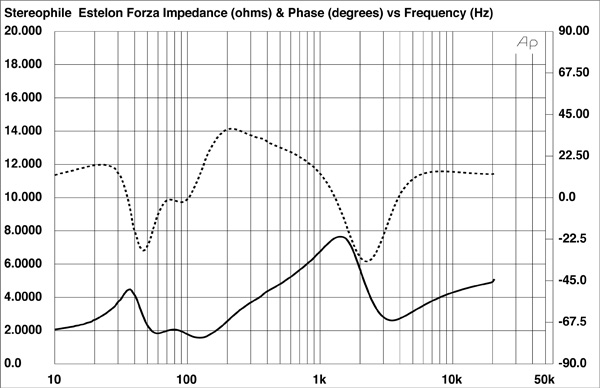
The traces in fig.1 are free from the small discontinuities that would imply that resonances of some kind are present. While I was performing the response measurements, I investigated the marble-composite enclosure's vibrational behavior by listening to the panels with a stethoscope. I couldn't hear any resonant modes, even when I turned up the volume!
The single peak centered on 35Hz in the impedance magnitude trace suggests that this is the sealed-box tuning frequency of the woofers, which corresponds to the frequency where the anechoic response is down by 6dB. The red trace in fig.2 shows the response of the two woofers close to the Forza's base, measured in the nearfield. The response peaks broadly between 35Hz and 100Hz, its steep upper-frequency rolloff disturbed by a small peak at 150Hz. The blue trace is the nearfield response of the midwoofer mounted at the top of the enclosure. It takes over from the bottom woofers at 85Hz and crosses over to the midrange unit (green trace) an octave higher in frequency. These nearfield responses are plotted in the ratios of the square roots of the radiating areas; the slight excesses of energy in the blue and red traces will be an artifact of the nearfield measurement, which assumes that the radiators are mounted in a true infinite baffle, ie, one that extends to infinity in both planes.
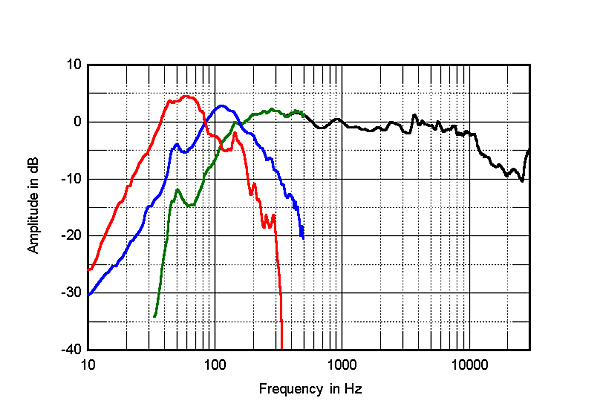
The black trace above 500Hz in fig.2 shows the Forza's farfield response averaged across a 30° horizontal window centered on the tweeter axis. The response is very even in the midrange through to 10kHz, but there is a gentle downward slope above that frequency. As with the Magico M2 that I reviewed in February 2020, which uses a diamond-coated beryllium-dome tweeter, the Estelon's use of a pistonic tweeter with a high-Q ultrasonic dome resonance results in a lack of energy in the region below that resonance.
Fig.3 shows the Forza's horizontal dispersion normalized to the response on the tweeter axis, which thus appears as a straight line. (The physical limitations of performing the measurements in MF's crowded room restricted the off-axis measurements to 15° to the sides rather than my usual 90°.) The loudspeaker's radiation pattern is smooth and even, though you can see that the tweeter's output above 15kHz has dropped significantly by 15° off-axis. (This will have affected the farfield response shown in fig.2.) Fig.4 shows the Estelon's vertical dispersion, again normalized to the response on the tweeter axis, which is 42" from the floor. The response 5° below the tweeter axis, which will be close to MF's listening axis, is similar to the tweeter-axis response. The suckout in the crossover region between the midrange unit and tweeter doesn't occur until 15° above the tweeter axis.
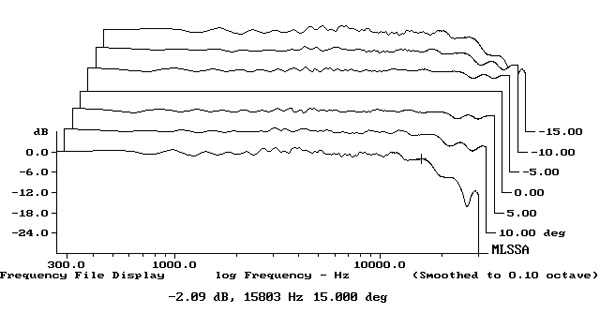
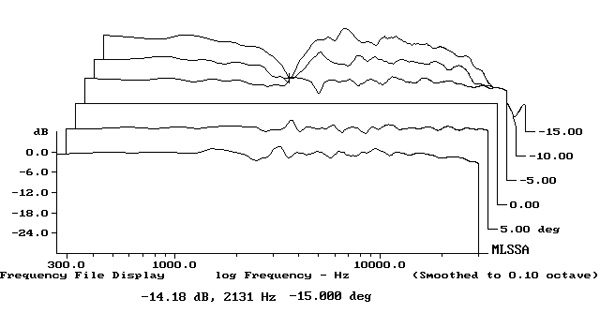
The red trace in fig.5 shows the Estelon Forzas' 1/10-octave–smoothed, spatially averaged response in MF's room. (The spatial averaging, footnote 2, tends to average out the peaks and dips below 400Hz that are due to the room's resonant modes.) The blue trace is the 1/6-octave–smoothed spatially averaged response, measured with Fuzzmeasure 3.0 rather than MLSSA, of the Wilson Chronosonic XVXes that were being used before the Estelon Forzas were installed. Both pairs of speakers have a little too much midrange energy at the listening position, but the Estelons have significantly more energy in the mid-treble region and less in the top audio octave. Both pairs of speakers excite the room mode at 50Hz to a similar extent, though the Wilsons feature more extended lows. Even so, the Forza's output is down by just 4dB at 20Hz. This is a full-range loudspeaker!
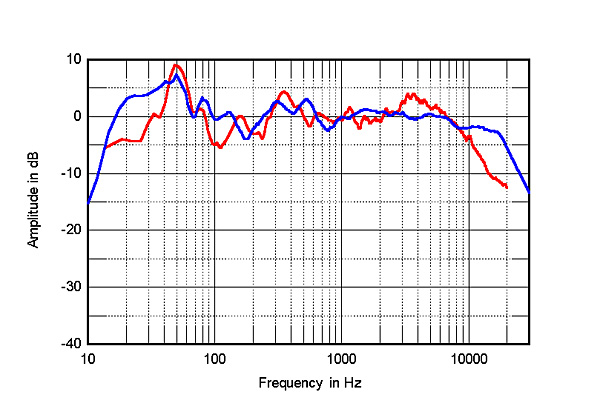
In the time domain, the Forza's step response on the tweeter axis (fig.6) reveals that the tweeter, midrange unit, and bottom woofers are all connected in positive acoustic polarity, the top midwoofer in inverted polarity. The decay of the tweeter's step smoothly blends with the positive-going start of the midrange unit's step, the decay of the midrange unit's step blends smoothly with the negative-going start of the top woofers' step, and the positive-going decay of that woofer's step smoothly blends with the start of the bottom woofers' step. Together with the profiling of the front baffle and the group delay in the crossover regions, this implies optimal implementation of the crossover filters. Other than some low-level ridges of delayed energy in the low treble, which might be due to early reflections from the baffle edges, the Forza's cumulative spectral-decay plot (fig.7) is clean, especially in the region covered by the tweeter.
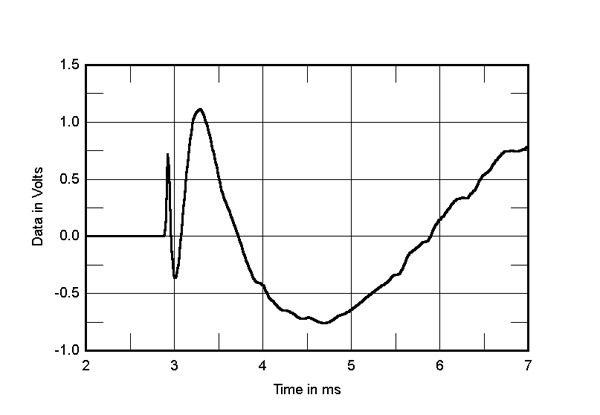
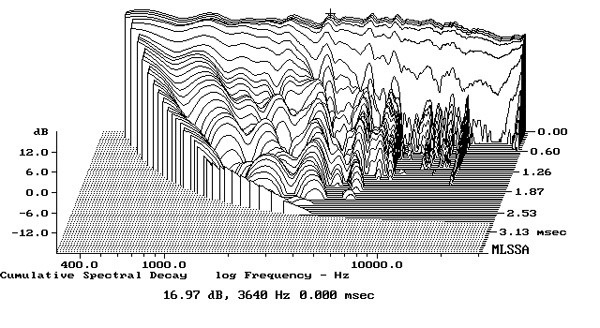
The Forza's measured performance indicates excellent audio engineering, though that amplifier-punishing impedance will give less-than-heroic amplifiers conniptions.—John Atkinson
Footnote 2: Using MLSSA, I averaged 20 1/10-octave–smoothed power spectra, individually taken for the left and right speakers, in a rectangular grid 36" wide by 18" high and centered on the positions of Mikey's ears.


They are strongly reminiscent of the KEF Muon.

One does not simply 'eliminate' diffraction. You simply eliminate it's deleterious effects by rounding off the edges of cabinets near the HF/mid-range drivers. John Crabbe wrote about this in 'Sidelines' in HFNRR in about 1986 - publishing lab findings using a single wide-band HF driver in three types of cabinet. A cube, a cube with rounded off edges at the front, and a sphere. Guess which had the best frequency response ? What was interesting was how close the cube with rounded edges was compared to the sphere. But the main thrust of the article was - you can't eliminate diffraction. His colleagues were using such phrases as 'eliminating diffraction effects' and he was keen to point out what was actually happening and encourage journalistic accuracy. What you are doing is smoothing the forward response by helping the diffraction. So curves on the sides of loudspeakers don't eliminate diffraction. They help it. But the make it smoother and so you don't get the sharp effects with sharp corners. They reduce it's effects. But you can't eliminate it - except if you put the drivers in the walls perhaps.................

No, sorry not to me, also why in the second pic down (the black/white shot) is the top left of the speaker slightly higher than the left, where the bottom is dead square. Or is it my $$$$ monitor
And the first color shot too, now that I look???
"The EPDR (footnote 1) drops to 1 ohm at 53Hz, to 0.8 ohm between 144Hz and 166Hz, and to 1.38 ohms at 2.8kHz. The Forza must be used with amplifiers that don't have problems driving 1 ohm loads."
Luv a speaker that needs a brute amp to drive it, sorts the men out from the boys.
Cheers George

My monitor is at least one or two $ below yours, and yet it provides corroborating evidence for both of your observations.

Sorry Mikey, I could not hear the first track of (Icemusic) above the sound of the paintings falling off my walls from the low bass.
But seriously, does someone on the list want to chime in on what the enema bag speaker, slime trail speaker and whipped cream speaker are?
I have some good guesses, having owned some of them, but would like to see what others think.

Slime Trail: B & W Nautilus. I am pretty confident about this one.
Enema Bag: MBL 101e?
Whipped Cream: I am still thinking.

What are "hen" premeasured crossover components?
Are they better than "rooster" premeasured?
Just curious.

Outsourcing critical componants means letting go of 'piece to piece' quality control which is especially critical if you are attempting to maintain peak performances.
Top Level Manufacturers have taken to building their own critical parts, which is exactly what the buyer is paying top dollar for. example : have a look at Abyss in Buffalo NY ( or Ferrari Auto in Italy )
Outfits that outsource critical parts are Second Tier, which is acceptable but it's nothing to brag about.
Tony in Florida


Exactly, You are Spot on, you get the concept.
GM is turning to S#$T in most things and its sad to see.

Outsources tubes, are they second tier now?

Yes, of course !
Jason & Mike are designers , their outfits assemble ( California & Texas ).
They have costs reflective of ultra efficient manufacturing designing. It's what they specialize in: maximise performance vs. cost.
Tubes are getting super high priced from the new manufacturers now. I'm hearing $1,800 for a pair of NEW 300B.
Jump over to Tesla and have a look at how they are building everything including the Batteries. They report that the OEMs can't supply consistent quality needed by Tesla.
Thank for writing, I've always admired your thinking.
Tony in Florida
ps. This loudspeaker outfit is taking me thru set-up training -- Right Now as I write this ! ---

Loudspeakers are not cars, last time I checked, but both often have crappy drivers.

Why the personal attacks ?
This is a rather Scientific, anyalytical type discussion, isn't it ?
Your : "Last time I checked" reads like angry sarcasm.
Accuton makes pretty darn nice transducers, as far as I can see. Some Auto outfits use them in their cars.
Resale of these Loudspeakers is gonna be a problem, perhaps.:
Warranty doesn't transfer
Factory packaging is intricate, specific and have to be stored which will take up considerable space. Set-up seems to need a factory specialist , the Factory suggests the need for two powerful men that also understand all that is required and needed for a proper installation.
I'm curious about blown Driver replacements, how is this accomplished and by whom???
There is a lot going on with this product range, the Dealers are gonna have to be better technicians than any Audio Dealer I've encountered. These products make Wilsons seem simple.
Tony in Florida
ps. how does the Dealer repair a Scratch ??

Companies build in house crap all the time. The issue is not where it's built but rather whether or not attention is paid to QC either in-house or "take out".

Are you now a housing design specialist ? , an architectural engineer ? a Standards specifier ?
I am aware of High End Luxury Custom guys that build one of a kind places that have Inspection Issues.
Todays building Standards are enforced because of Insurance Industry underwriting.
Older building tracts that were allowed Aluminium wiring are probably the Crap problem you are referring to.
There are an abundance of rumours about NJ building inspectors bribery, your case kinda supports that anger.
Tony in Florida

Has set in for these. BRB, going to go see if Best Buy has a pair. A number of dealers in SoCal, I might have to find an excuse to go there.

What the speakers are you described in the first paragraph. Dying to know!

Most people have the feeling that Mecerdes make the finest Cars in the World ( I think Tesla does ).
Still, Mercerdes S Class cars are Outstanding Engineering Examples, always at the forefront ( except now because of Tesla ).
My Local Mercedes Dealer presents an entry level S Class for $109,000 with a total 5 Cars ranging in MSRP to $143,000.
I ask any knowledgable person to explain how this interesting loudspeaker is an equivalent to a Mercedes S Class and how it's phenomenal price is justified.
Is this like buying a pricy painting from the son of a famous person? seem like it !
Tony in Florida

Of MB as well? If not, why not? Why is an MB five times the price of a Toyota transportation appliance? What makes an MB worth that five times the cost? Why would those reasons an MB is worth the cost not apply to something else?

The Toyota Corolla has been the Industry Value Leader since 1990, til KIA presented the SOUL around 2011ish. Koreans deliver German Level Engineering, Japanese Build Quality with Chinese Pricing. KIA make our Cars in Alabama ( I think ).
However, the S Class is Gold Standard in the Automotive Industry. Gold Standard for price setting , Gold Standard in Status / Ego and Gold Standard for ICE performance.
The Tesla Engineered Cars have relegated all the ICE cars ( including the S Class ) into Buggy Whip stodginess.
Tony in Florida

Have you heard the new Diptyque Audio Reference Loudspeakers yet ?

I’ve never seen or heard a better speaker in my lifetime. They were magic on all types of music. I did realize one thing though. If the music doesn’t have it recording wise they will not give you anything more than the recording does, but if it’s there in the recording you’ll hear like you have never heard it before!